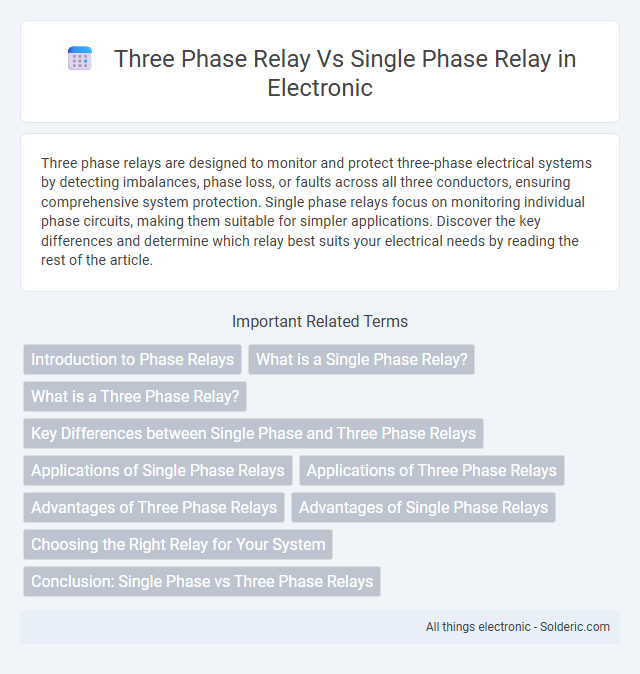Three phase relays are designed to monitor and protect three-phase electrical systems by detecting imbalances, phase loss, or faults across all three conductors, ensuring comprehensive system protection. Single phase relays focus on monitoring individual phase circuits, making them suitable for simpler applications. Discover the key differences and determine which relay best suits your electrical needs by reading the rest of the article.
Comparison Table
| Feature | Three Phase Relay | Single Phase Relay |
|---|---|---|
| Function | Monitors all three phases for fault detection | Monitors a single phase for fault detection |
| Application | Used in three-phase electrical systems and motors | Used in single-phase electrical systems and motors |
| Protection | Provides phase imbalance, phase loss, and overload protection | Provides overload and short circuit protection for one phase |
| Complexity | More complex due to monitoring multiple phases simultaneously | Simpler design, monitoring only one phase |
| Cost | Typically higher cost due to complexity | Lower cost, simpler implementation |
| Installation | Requires connection to all three phase lines | Connects to only one phase line |
| Fault Detection | Detects phase loss, phase sequence errors, and unbalance | Detects overcurrent and short circuit in single phase |
Introduction to Phase Relays
Phase relays monitor voltage levels and phase conditions in electrical systems to protect machinery from faults. Three phase relays are designed to handle and protect all three phases simultaneously, ensuring balanced operation and detecting phase loss or imbalance. Single phase relays focus on one phase, making them suitable for simpler, single-phase applications but less effective in complex, three-phase systems.
What is a Single Phase Relay?
A single phase relay is an electrical device designed to protect and monitor single-phase power systems by detecting faults such as overloads, under-voltage, or phase failures. It operates by sensing current or voltage variations in one phase to trigger protective actions like disconnecting the circuit. Your choice of a single phase relay ensures reliable protection in residential or light commercial applications where single-phase power is used.
What is a Three Phase Relay?
A Three Phase Relay is an electrical device designed to monitor and protect three-phase power systems by detecting faults such as overcurrent, phase imbalance, or phase failure. Unlike single phase relays, it simultaneously analyzes all three phases, ensuring coordinated protection and maintaining system stability. Your three-phase relay enhances safety and efficiency in industrial and commercial power distribution networks by preventing equipment damage and minimizing downtime.
Key Differences between Single Phase and Three Phase Relays
Single phase relays protect electrical circuits powered by single phase systems, typically used in residential or light commercial applications, while three phase relays are designed for three phase systems common in industrial settings with higher power loads. Three phase relays monitor three line inputs simultaneously, ensuring balanced operation and detecting phase loss or imbalance, whereas single phase relays only monitor a single line voltage or current. Choosing the correct relay depends on your power system configuration, with three phase relays offering more complex protection features for multi-phase equipment.
Applications of Single Phase Relays
Single phase relays are predominantly used in residential and small commercial electrical systems, where monitoring and protection of single phase motors and appliances are crucial. These relays safeguard your equipment by detecting phase failures, overloads, and under-voltage conditions, ensuring reliable operation and preventing damage. Their applications include air conditioners, pumps, and heating systems, where precise control of single phase power is essential.
Applications of Three Phase Relays
Three phase relays are widely used in industrial motor protection, power generation, and distribution systems due to their ability to monitor all three phases simultaneously, ensuring balanced load conditions and preventing phase failure damage. These relays detect phase imbalances, overcurrent, undercurrent, and phase loss in three-phase motors and transformers, enhancing operational reliability and equipment longevity. Their application is critical in large-scale manufacturing plants, HVAC systems, and utility grids where continuous three-phase power is essential for optimal performance and safety.
Advantages of Three Phase Relays
Three phase relays provide enhanced protection for industrial and commercial electrical systems by monitoring all three phases simultaneously, allowing for accurate detection of phase imbalances, phase loss, and overload conditions. They minimize downtime and equipment damage by offering coordinated tripping mechanisms that respond to abnormalities more swiftly and precisely compared to single phase relays. Their ability to improve system stability and ensure balanced load distribution makes them essential in complex three phase power networks.
Advantages of Single Phase Relays
Single phase relays offer simplicity and cost-effectiveness, making them ideal for residential and small commercial applications where three phase power is not available. They provide reliable protection for single-phase motors and equipment by detecting overcurrent, undercurrent, or phase loss conditions. Their compact size and ease of installation contribute to reduced maintenance and operational costs compared to three phase relays.
Choosing the Right Relay for Your System
Selecting the right relay for your system depends on the electrical load and phase type; three phase relays are essential for managing balanced loads in three-phase power systems and offer better protection for motors and industrial equipment. Single phase relays suit simpler, single-phase circuits such as residential appliances, providing cost-effective monitoring and control. Consider system complexity, load characteristics, and required protection features to optimize performance and reliability.
Conclusion: Single Phase vs Three Phase Relays
Single phase relays are designed for simpler electrical systems with lower power requirements, offering cost-effective protection for single phase motors and circuits. Three phase relays provide advanced monitoring and fault detection in industrial environments, ensuring balanced load management and enhanced safety for three phase motors and equipment. Choosing between single phase and three phase relays depends on the application's complexity, voltage requirements, and the need for comprehensive phase protection.
Three phase relay vs single phase relay Infographic

 solderic.com
solderic.com